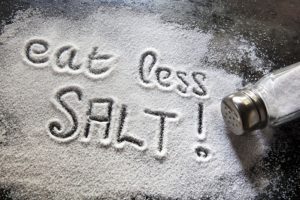Tips for Reducing Salt in the Diet

Why is salt important?
Salt (sodium chloride, or NaCl), along with potassium, is very important in helping your body maintain normal cell function and a proper fluid balance. Salt allows your body to take in fresh fluids, eliminate fluid waste through your urine, and still stay in fluid balance. Fluid balance is important for many body functions, including maintaining blood pressure, avoiding dehydration, and keeping the kidneys healthy. Too little salt keeps brain, heart, and muscle cells from working properly.
Too much salt, however, can cause health problems. It can cause you to retain water, resulting in uncomfortable swelling of the hands, feet, and sometimes abdomen. Some women are more salt-sensitive before their periods. They are more likely to gain weight and have swelling and bloating from salt at this time.
A serious problem related to too much salt is high blood pressure. High blood pressure increases your risk for heart disease and strokes. Approximately one third of people with high blood pressure in the United States are especially salt sensitive. This means that if they eat too much salt, it will cause or worsen high blood pressure.
What is the recommended amount of salt?
You should have no more than 4 grams of salt (about a teaspoonful), or 2.4 grams (2,400 mg) of sodium, a day. The average adult consumes quite a bit more sodium than this (at least 4 to 7 grams of sodium daily).
How do I decrease the salt in my diet?
You can take several steps to decrease the salt in your diet:
- Stop adding salt to food at the table. One third to one half of the sodium people eat is added at the table or during cooking. Sometimes you can use other spices or salt substitutes that do not contain sodium.
- Use littlea or no salt during food preparation and cooking. Use other spices instead of salt.
- Read the labels on all canned, boxed, or frozen foods to see how much salt they contain. Many soups, frozen dinners, and other convenience foods contain high levels of sodium.
- Check the sodium content in snack foods, especially the ones that taste salty but even those that aren’t obviously salty.
- Don’t use of a lot of sauces and condiments on foods.
Examples of sodium content in common foods:
Food Sodium Content
apple 1+1/2 mg
banana 1 mg
broccoli, 2/3 cup 10 mg
catsup, 1 T 200 mg
carrots, 2 50 mg
cheddar cheese, 1/4 lb 700 mg
chicken, broiled, 1/4 lb 70 mg
chicken, Burger King Broiler 480 mg
dill pickle, 1 medium 900 mg
eggs, 2 270 mg
hamburger, Burger King 570 mg
hamburger, Burger King Whopper 870 mg
margarine, 1 T 120 mg
milk, 2%, 8 oz 120 mg
mustard, 1 tsp 65 mg
olives, green, 10 940 mg
salt, 1 tsp 1938 mg
Worcestershire sauce, 1 T 206 mg
Decreasing sodium is one of the easiest changes you can make in your diet. Once you start a low-sodium diet, your tongue becomes more sensitive to the salt content in foods. Eventually you will not notice the lack of salt. The change takes about 30 days for most people. Use natural spices like oregano and rosemary to add flavor, but beware of seasonings with hidden salt, such as Cajun seasoning and blackening spices.
If you are taking medicine or have any medical conditions, be sure to check with your health care provider before changing your diet.